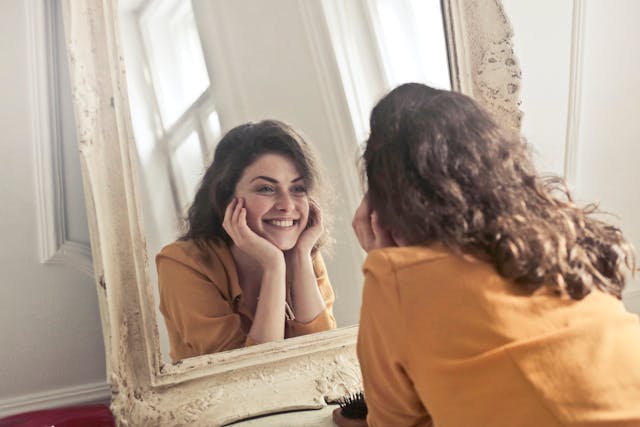Body Dysmorphic Disorder Therapy
Are You Consumed With Negative Thoughts About How You Look?
Is it hard for you to pass a mirror without noticing imperfections? Are there parts of your body—perhaps your skin, hair, nose, or stomach—that you fixate on and try to camouflage, conceal, or alter? Does it take hours to get out of the house each morning as you apply makeup or try different clothes to mask your “defect”?
Even though you may receive constant reassurance from family and friends that you look fine, it’s never enough to quell the anxiety you feel. No amount of makeup, surgery, exercise, or attempts to camouflage can change the way you perceive certain physical flaws in your appearance. As a result of these intrusive thoughts, you may feel compelled to engage in behaviors to reduce your anxiety and discomfort.
You May Feel Anxious Or Depressed About How You Look
Your mantra might be, “If I am not attractive, I will never be happy,” or “People will like me more if I alter X about my body.” But no matter how perfect you try to look, you can’t seem to silence your highly critical inner voice. To quiet it, you might feel compelled to perform intricate makeup or grooming rituals, check the mirror constantly, pick at your skin, camouflage your problem area with clothing or tanning, or undergo plastic surgery procedures.
Being stuck in this negative loop may lead to anxiety and depression, negatively impacting your quality of life. As a result of your distress, you may turn to substances for relief.
Maybe you assume that everyone feels as insecure about how they look as you do and think that what you are experiencing is normal. However, if you are preoccupied with your appearance to the point where you engage in compulsive or ritualistic behaviors to alter it, you may have Body Dysmorphic Disorder (BDD). Fortunately, BDD is treatable with therapy.
Body Dysmorphia Is More Common Than You May Realize
In the Diagnostic and Statistical Manual of Mental Disorders, Fifth Edition (DSM-5), Body Dysmorphic Disorder (BDD) is listed within the category of obsessive-compulsive and related disorders. Similar to the Obsessive-Compulsive Behavior (OCD) cycle, with BDD, intrusive thoughts—in this instance, one’s physical appearance—trigger compulsive behaviors to reduce the ensuing anxiety. [1][2] Although BDD can affect people of any age, gender, or educational level, the average age of onset is 16, but it can appear as early as 12 years old. [3]
Although BDD is more common than OCD, Anorexia Nervosa, and Schizophrenia, many of us are resistant to the idea that we suffer from it. [3] Often associated with eating disorders, it’s important to recognize that BDD is a distinct condition that requires understanding and awareness.
Social Media Reinforces Unrealistic Body Image
Unfortunately, BDD has been exacerbated in recent years by the influence of social media in our culture. With myriad filters available to doctor the original photo, the “high-gloss” images we see as we scroll through Instagram and TikTok are far from realistic representations of their original subject. What’s more, social media’s focus on physical beauty implicitly reinforces the notion that appearance is equivalent to happiness, success, and financial prosperity.
In addition to social media, face and body-altering practices such as Botox and cosmetic surgery have become mainstream, especially here in Los Angeles. Normalizing the use of injections, fillers, and surgery as a rite of passage for younger women has further warped our perception of physical appearance.
If you fear you or a loved one may suffer from BDD disorder, the good news is that treatment is available. The same types of therapy we use to treat OCD, such as Exposure and Response Prevention (ERP) therapy and Acceptance and Commitment Therapy (ACT), can be used for body dysmorphic disorder.
Body Dysmorphic Disorder Therapy Helps You Feel More Comfortable In Your Own Skin
As body dysmorphic disorder specialists, we understand that you may be unsure if you have BDD or are just experiencing normal body image issues. The distinction with BDD is that the obsessive thoughts and compulsive behaviors you have related to appearance are all-consuming. These thoughts keep you preoccupied, hypervigilant, and stuck. BDD shrinks your life—controlling where you go and what you do—to the point of exhaustion.
If you suffer from body dysmorphic disorder and feel ready to talk about it, therapy is a safe space to discuss how you perceive yourself openly with no fear of judgment. You will be matched with a therapist who understands what BDD is and knows how to treat it so you accept how you look and feel better about yourself.
What To Expect In BDD Counseling Sessions
Initially, your therapist will build rapport with you, ensuring that you feel seen, heard, validated, and accepted. In body dysmorphic disorder therapy, we will explore and track your thoughts and behavior related to appearance to get a better sense of how often you become preoccupied with how you look. We will examine what you do when you notice something about your appearance you don’t like and how this may impact or interfere with how you go through your day.
For example, you might spend hours applying makeup, attempting to camouflage body parts, or researching hair or skin products online that you think may address your issues. Once we have identified what intrusive thoughts you struggle with and what behaviors they trigger, we will establish common goals for what you want to change.
The Modalities We Use For Body Dysmorphic Treatment
Drawing from a blend of modalities, we can help you alter your perception of your appearance and reduce the compulsive behaviors associated with those perceptions. We utilize Acceptance and Commitment Therapy (ACT), Dialectical Behavioral Therapy (DBT), TIPP skills, and Exposure and Response Prevention (ERP) therapy for body dysmorphic disorder.
With ERP, we develop a hierarchy of compulsions from mildest to most severe, allowing you to tackle anything you currently avoid, such as walking past a mirror without looking at yourself or camouflaging. Through exposure, we can reduce your engagement in compulsions while at the same time observing the mental chatter associated with these rituals. Keeping thought records will help build awareness of cognitive distortion and negative core beliefs.
ACT, DBT, and TIPP skills can help you establish better emotional regulation and distress tolerance that allow you to surf difficult moments more easily. Using a values pie chart, ACT allows you to shift your values so they expand well beyond appearance into other realms of your life.
As body dysmorphic disorder therapists, the goal isn’t to change the way you look but to change the way you feel about your appearance. BDD therapy makes it possible to live a more meaningful and empowering life that no longer revolves around body image.
But You May Have More Questions About Body Dysmorphic Disorder Therapy …
How can I tell if I have body dysmorphia and need therapy?
Understanding and learning about BDD can take time. It’s normal to feel ambivalent and hesitant about starting therapy if you are unsure you have body dysmorphia. To ensure we provide appropriate treatment, your therapist will have you complete a thorough body dysmorphia assessment. If you meet the criteria for body dysmorphic disorder, therapy sessions will focus on psychoeducation so that you can build the motivation and awareness to treat your BDD and be open to coping skills that will help you feel better.
Treatment for my body dysmorphic disorder hasn’t worked before—how will working with a therapist at Embracing You Therapy be different?
It is important to work with a therapist specializing in body dysmorphia who understands how BDD shows up in your life. Based on evidence-based research and best practices, we offer the interventions that have been demonstrated as the best treatments for body dysmorphic disorder, such as Acceptance and Commitment Therapy (ACT), Exposure and Response Prevention (ERP), dialectical-based therapy, and TIPP skills. Exposure therapy coupled with cognitive reframing, mindfulness, and emotion regulation skills will give you the best foundation to manage your BDD
You Can Accept And Love How You Look
If your appearance is a nagging concern you can’t let go of, we can help. To schedule an appointment to begin body dysmorphic disorder therapy at our Woodland Hills therapy practice or online, please fill out the contact form to schedule a free phone consultation.
[1] https://www.verywellhealth.com/body-dysmorphia-5272235#citation-2
[2] https://dictionary.apa.org/body-dysmorphic-disorder
[3] https://focus.psychiatryonline.org/doi/10.1176/appi.focus.20210012



